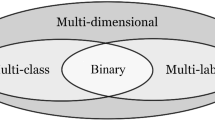Abstract
In the pattern recognition literature, Huang and Suen introduced the “multinomial” rule for fusion of multiple classifiers under the name of Behavior Knowledge Space (BKS) method [1]. This classifier fusion method can provide very good performances if large and representative data sets are available. Otherwise over fitting is likely to occur, and the generalization error quickly increases. In spite of this crucial small sample size problem, analytical models of BKS generalization error are currently not available. In this paper, the generalization error of BKS method is analysed, and a simple analytical model that relates error to sample size is proposed. In addition, a strategy for improving performances by using linear classifiers in “ambiguous” cells of BKS table is described. Preliminary experiments on synthetic and real data sets are reported.
Access this chapter
Tax calculation will be finalised at checkout
Purchases are for personal use only
Preview
Unable to display preview. Download preview PDF.
Similar content being viewed by others
References
Huang, Y.S. and Suen, C.Y. A method of combining multiple experts for the recognition of unconstrained handwritten numerals. IEEE Trans. On Pattern Analysis and Machine Intelligence 17(1) (1995), pp. 90–94.
C.Y. Suen, L. Lam. Multiple classifier combination methodologies for different output levels. Springer-Verlag Pub., Lecture Notes in Computer Science, Vol. 1857 (J. Kittler and F. Roli Eds., 2000), pp. 52–66.
S. Raudys, Experts’ boasting in trainable fusion rules, IEEE Trans. on Pattern Analysis and Machine Intelligence, in press, 2003.
F. Roli, S. Raudys, G. Marcialis, An experimental comparison of fixed and trained fusion rules for crisp classifiers outputs, Springer Pub., Lecture Notes in Computer Science, Vol. 2364 (F. Roli, J. Kittler Eds., 2002), pp. 232–241.
C. K. Chow, On optimum error and reject tradeoff, IEEE Trans. on Information Theory, 16 (1970) 41–46.
S. Raudys. Combining the expert networks: a review. Proc. of the Int. Conference on Neural Networks and Artificial Intelligence, (R. Sadykhov Ed.), 2–5 October 2001, Minsk, Belorus, pp. 81–91
H.J. Kang, S.W. Lee, A dependency-based framework of combining multiple experts for the recognition of unconstrained handwritten numerals, Proc. 1999 Int. Conf. On Computer Vision and Pattern Recognition, Fort Collins, Colorado, USA, June 1999, pp. 124–129
H.J. Kang, S.W. Lee, Combining classifiers based on minimization of a Bayes error rate, Proc. 5 th int. Conf. On Document Analysis and Recognition, Bangalore, India, 1999, pp. 398–401
S. Raudys, Statistical and Neural Classifiers: an integrated approach to design, Springer, London, 2001
G. Giacinto, F. Roli, Dynamic cassifier selection based on multiple classifier behaviour, Pattern Recognition, 34(9), 2001, pp. 179–181.
M. Skurichina, S. Raudys, R.P.W. Duin. K-nearest neighbors directed noise injection in multilayer perceptron training, IEEE Tr. on Neural Networks, vol. 11, pp. 504–511, 2000.
Author information
Authors and Affiliations
Editor information
Editors and Affiliations
Rights and permissions
Copyright information
© 2003 Springer-Verlag Berlin Heidelberg
About this paper
Cite this paper
Raudys, Š., Roli, F. (2003). The Behavior Knowledge Space Fusion Method: Analysis of Generalization Error and Strategies for Performance Improvement. In: Windeatt, T., Roli, F. (eds) Multiple Classifier Systems. MCS 2003. Lecture Notes in Computer Science, vol 2709. Springer, Berlin, Heidelberg. https://doi.org/10.1007/3-540-44938-8_6
Download citation
DOI: https://doi.org/10.1007/3-540-44938-8_6
Published:
Publisher Name: Springer, Berlin, Heidelberg
Print ISBN: 978-3-540-40369-2
Online ISBN: 978-3-540-44938-6
eBook Packages: Springer Book Archive




